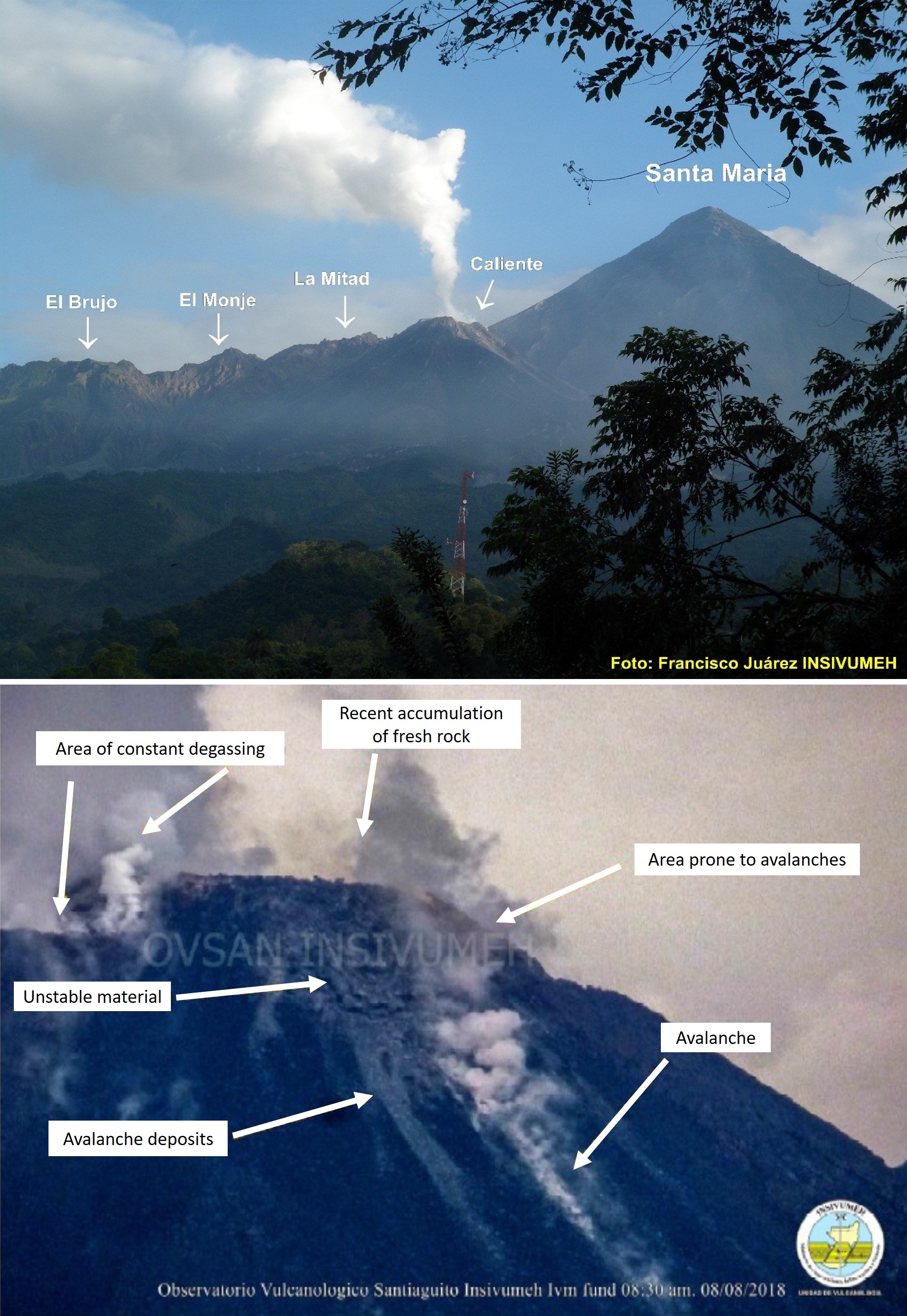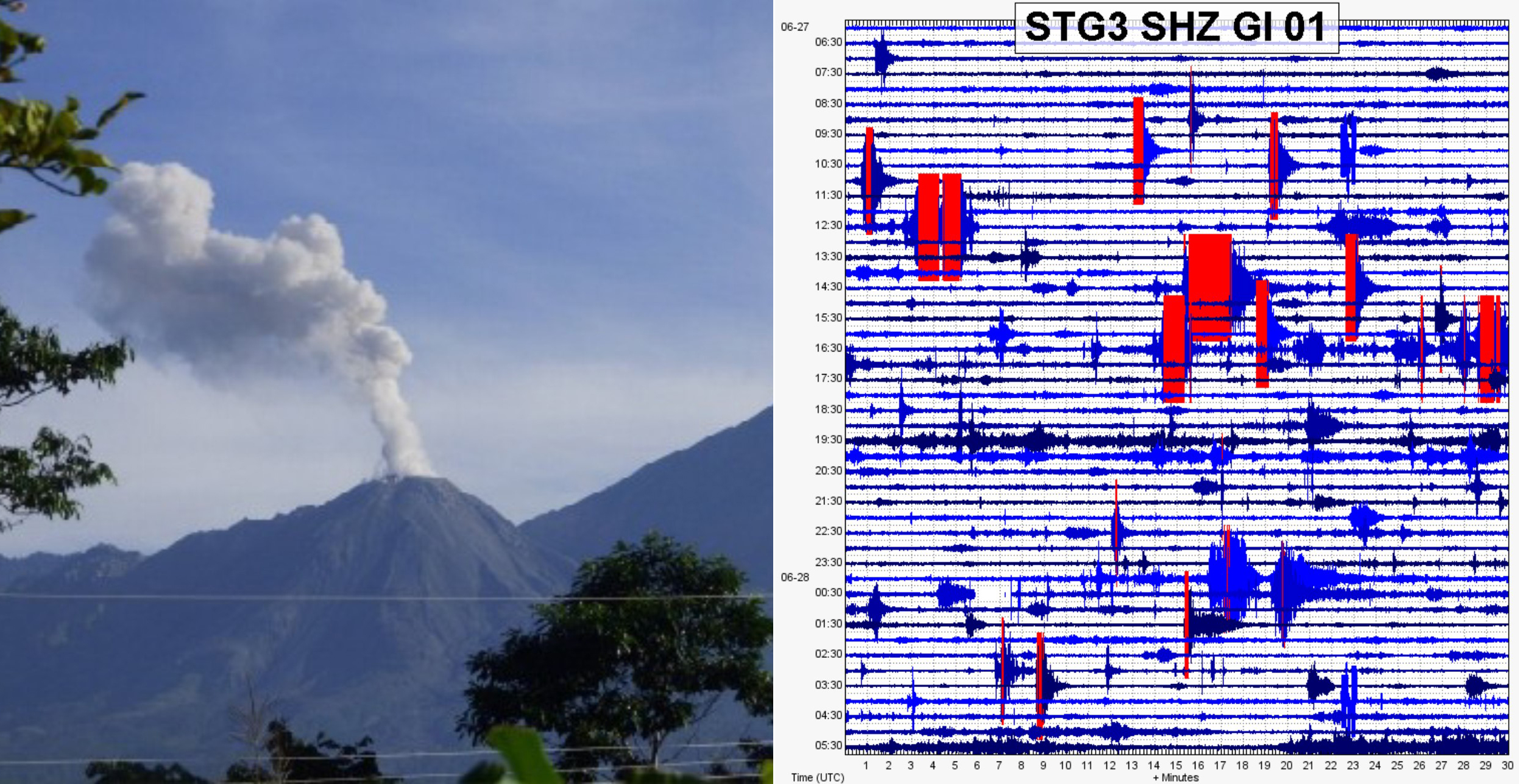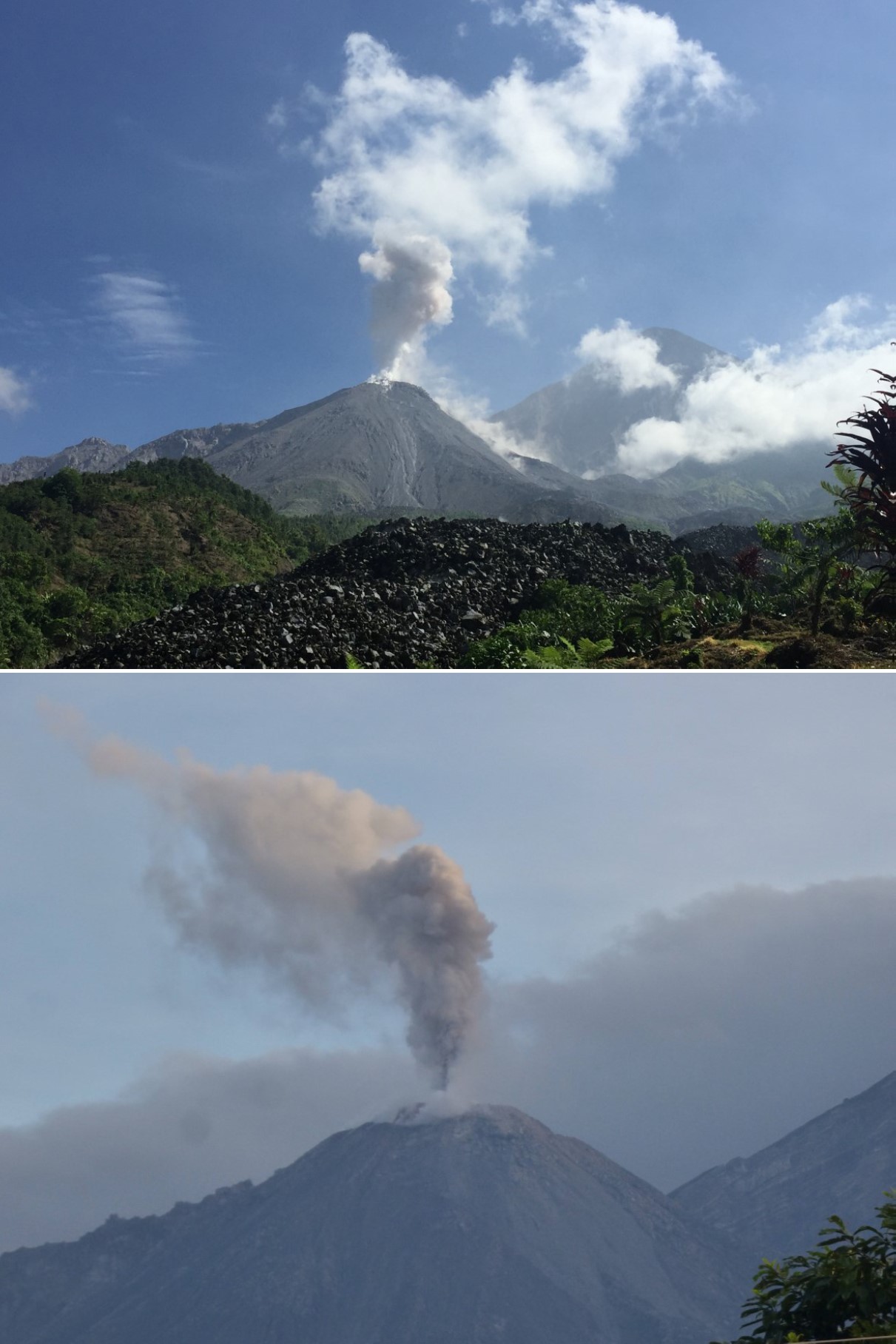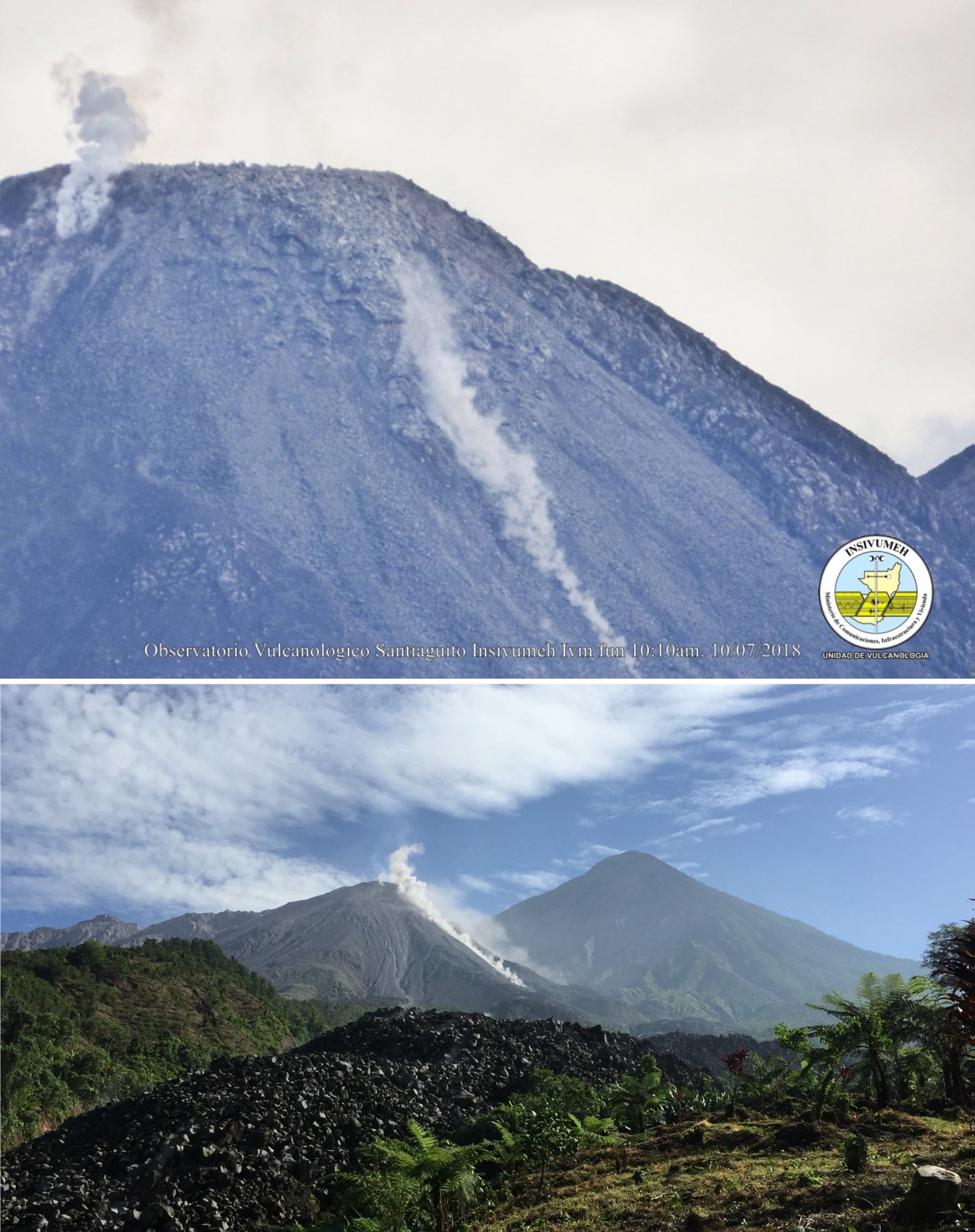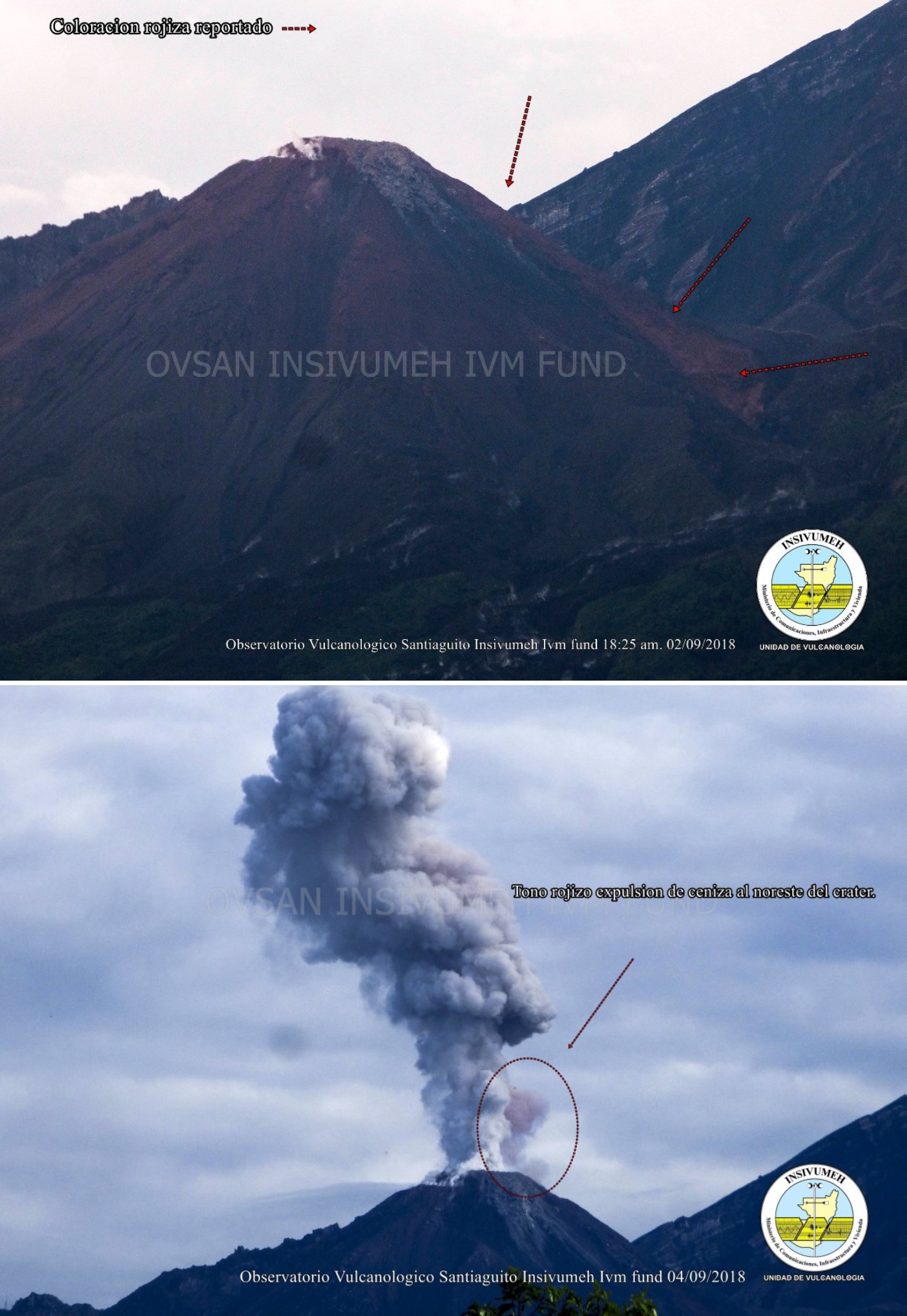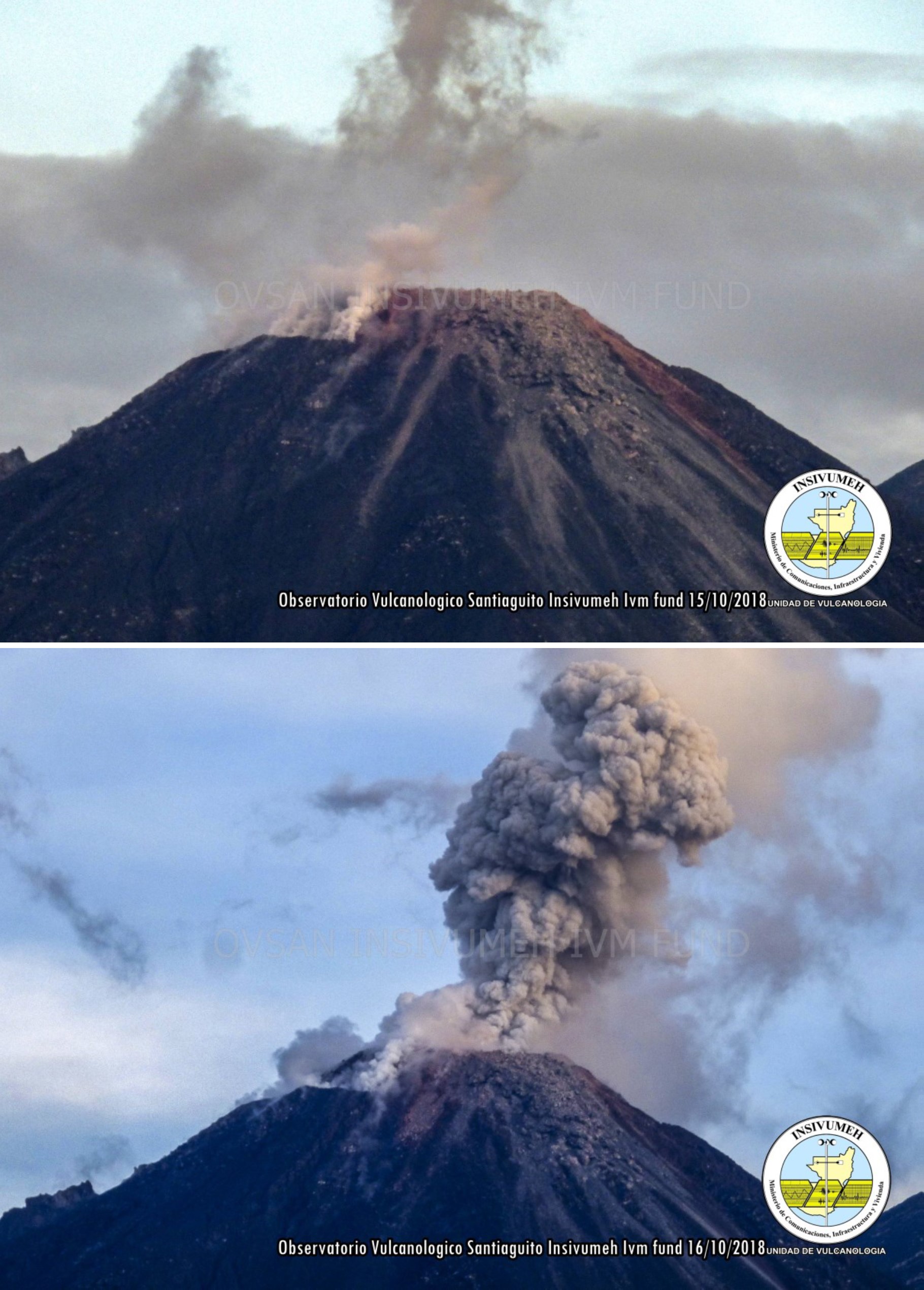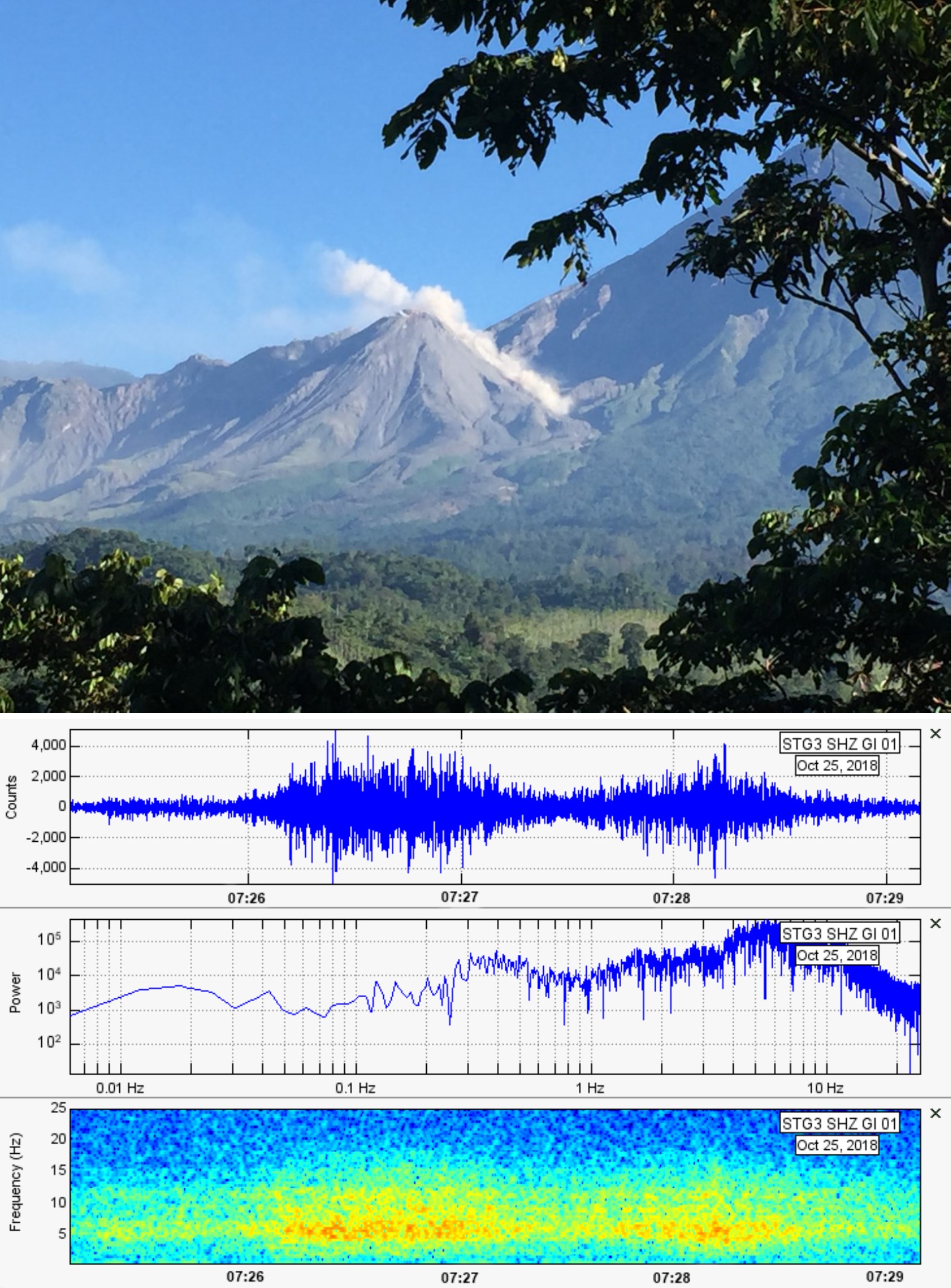Report on Santa Maria (Guatemala) — December 2018
Bulletin of the Global Volcanism Network, vol. 43, no. 12 (December 2018)
Managing Editor: Edward Venzke.
Edited by Janine B. Krippner.
Santa Maria (Guatemala) Ash plumes, degassing, and avalanches continue during May-October 2018 with occasional lahars
Please cite this report as:
Global Volcanism Program, 2018. Report on Santa Maria (Guatemala) (Krippner, J.B., and Venzke, E., eds.). Bulletin of the Global Volcanism Network, 43:12. Smithsonian Institution. https://doi.org/10.5479/si.GVP.BGVN201812-342030
Santa Maria
Guatemala
14.757°N, 91.552°W; summit elev. 3745 m
All times are local (unless otherwise noted)
Santa Maria is one of the most active volcanoes of Guatemala. The volcano is composed of a large edifice that reaches over 3.7 km above sea level; the Santiaguito dacitic dome complex to the SW, with the active Caliente dome, rises to a height of over 2.5 km (figure 77). The Santiaguito dome complex is situated in a large crater that formed during a catastrophic eruption in 1902. Growing since 1922, this complex has recently been characterized by dome-growth activity that includes degassing, ash plumes, avalanches, pyroclastic flows, lava flows, and lahars. This report summarizes activity from May through October 2018, and is based on reports by Guatemala's INSIVUMEH (Instituto Nacional de Sismologia, Vulcanologia, Meterologia e Hidrologia) and satellite data. During this period, activity consisted of degassing, ash plumes, and avalanches at the Caliente dome, and lahars in multiple tributaries. Intermittent low-power thermal anomalies were detected throughout this period (figure 78).
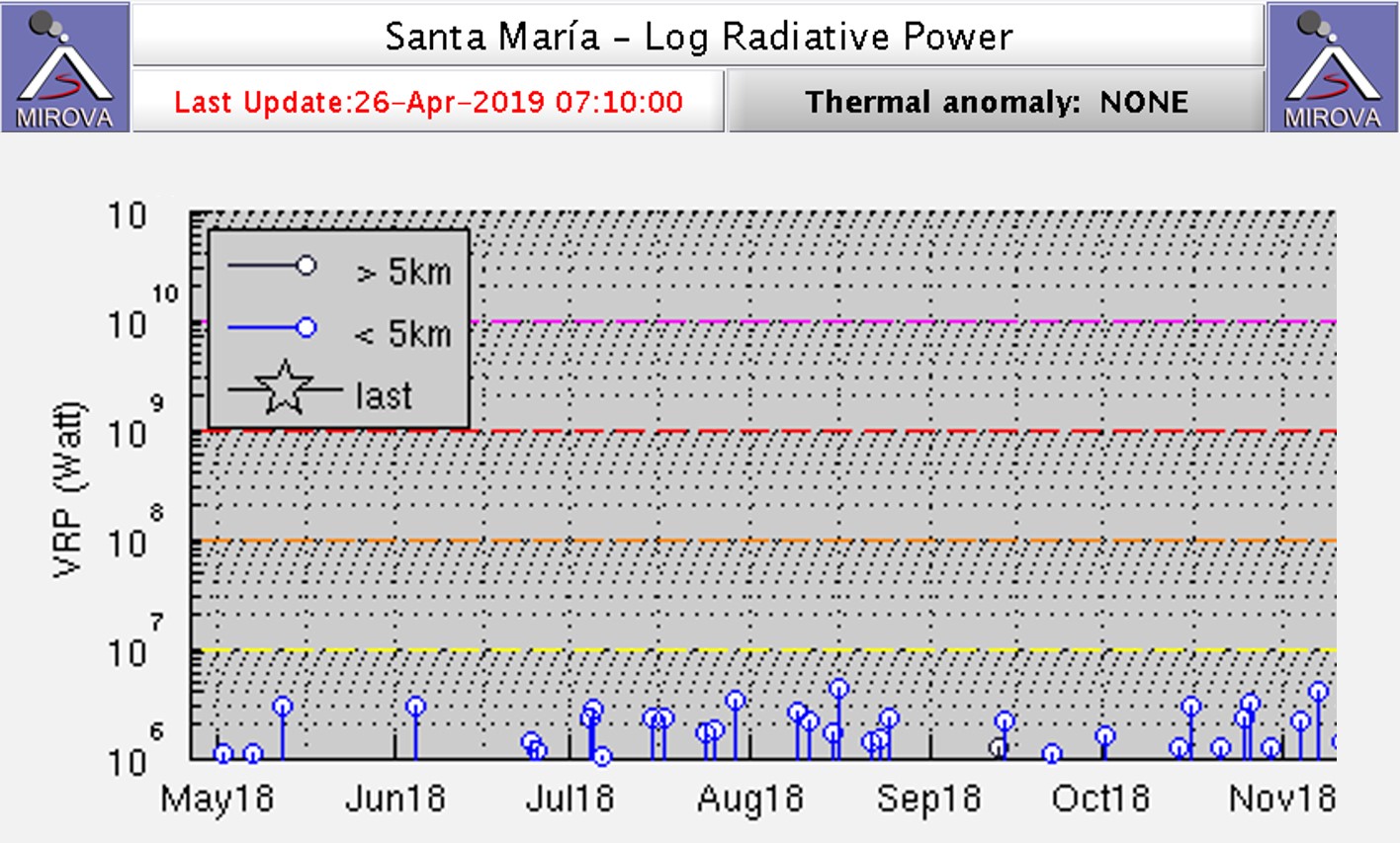 |
Figure 78. Log radiative power MIROVA plot of MODIS infrared data at Santa Maria for May through November 2018. Courtesy of MIROVA. |
Throughout May, active degassing of the dome produced white plumes up to 3.2 km above sea level. Frequent weak to moderate explosions produced white and gray ash plumes up to 3.3 km that were dispersed to the SW, W, and SE. As many as 15 explosions were recorded per day. Avalanches frequently occurred on the SE flank of the Caliente dome. The first lahar of the year was generated by rainfall on 10 May and traveled down the Cabello de Angel-Nimá I river. The lahar was composed of abundant fine material with larger branches and blocks up to 1 m in diameter, and it smelled of sulfur. The lahar deposit was 15 m wide and 1.2 m thick. A second lahar descended along the same path on 24 May and emplaced a deposit with a width of 18 m, a depth of 2 m, and blocks up to 2 m in diameter.
During June, white plumes associated with degassing of the Caliente dome often reached altitudes of 2.9 km, with a maximum of 3.9 km on 5 June. An average of 9-11 weak to moderate explosions per day ejected white and gray ash plumes up to 3.1-3.3 km altitude that were dispersed to the SW, W, and SE (figures 79 and 80). Ashfall was reported in Monte Claro on 26 June. Avalanches were recorded most days on the SE side of the dome due to ongoing growth. Lahars were reported on 13, 14, and 16 June down the Nimá I and Cabello de Ángel tributaries of the Samalá River (figures 81 and 82).
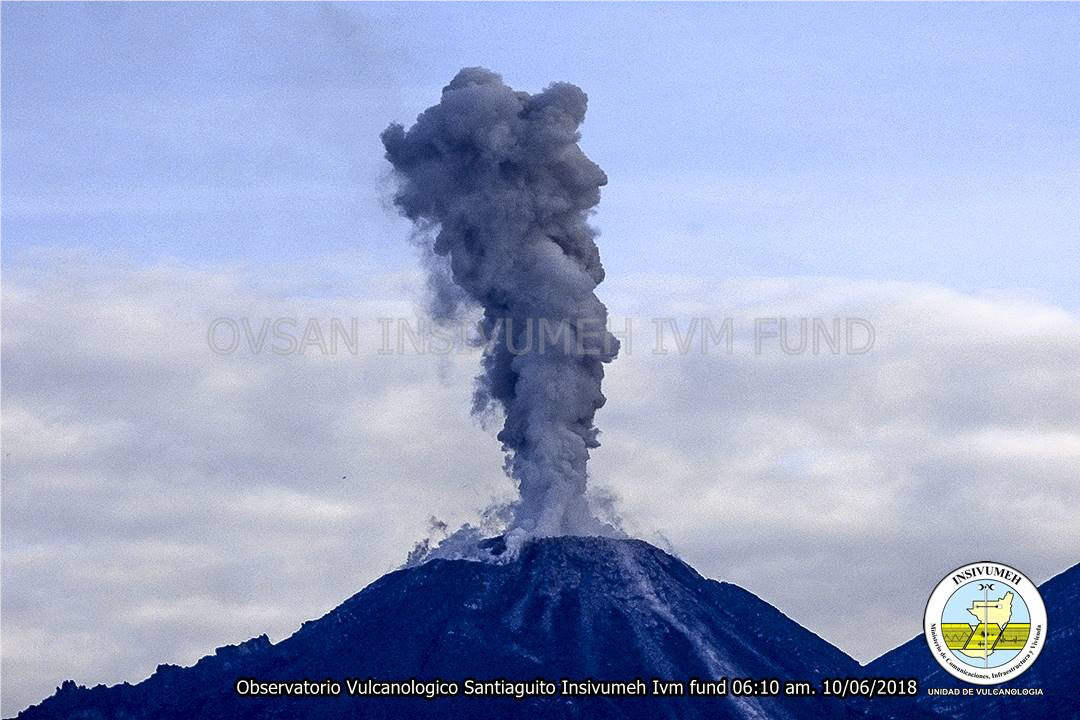 |
Figure 79. A moderate explosion from the Caliente dome at Santa Maria generated an ash plume on 10 June 2018. Courtesy of INSIVUMEH (9-15 June 2018 weekly report). |
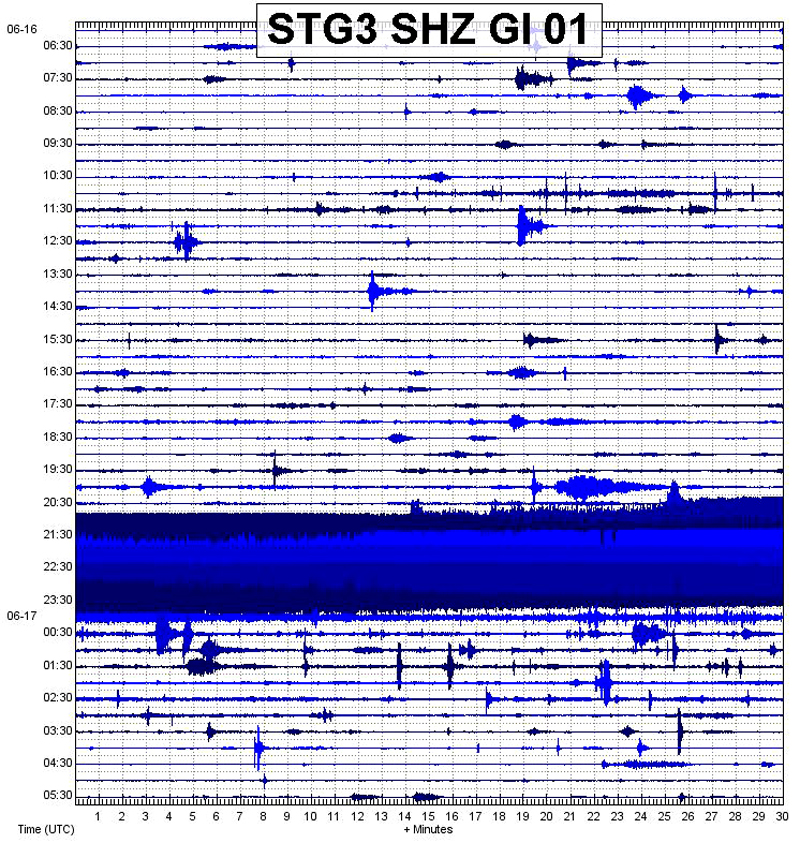 |
Figure 82. The seismic signal produced by a lahar at Santa Maria on 16 June 2018. The lahar traveled down the Nimá I river channel. Courtesy of INSIVUMEH (16-22 June 2018 weekly report). |
Throughout July, degassing of the dome and fumarolic activity produced white plumes reaching 3 km. These plumes were dominantly directed towards the SW and SE, and on a few days towards the N and W. Explosions frequently produced white and gray ash plumes up to 11 times per day (figure 83). Ash plumes often reached approximately 3.2 km altitude, drifted SE, SW, and W, and frequently deposited ash on the flanks. On 4 July an explosion produced incandescent material up to 150 m above the crater and the accompanying sound was heard in areas including El Palmar, Pueblo Nuevo, and San Felipe Retalhuleu. Avalanches most often occurred on the SE flank of the dome, with some occurring on the N, NE, and W flanks (figure 84). Incandescence was observed on the 11 July.
Through August, degassing of the dome regularly produced white plumes up to a maximum observed altitude of 3.2 km (figure 85). Explosions generated white and gray ash plumes up to 3.1-3.3 km on most days, with a maximum of 13 explosions recorded per day. Gas-and-steam and ash plumes were often dispersed to the SE and sometimes towards the W. Ashfall often occurred on the slopes. Avalanches on the dome were recorded most days on the SE flank and sometimes on the E, NE, and W flanks. On 17 August at 1330 a lahar emplaced a deposit 18 m wide and 2.5 m thick, with blocks up to 3 m in diameter.
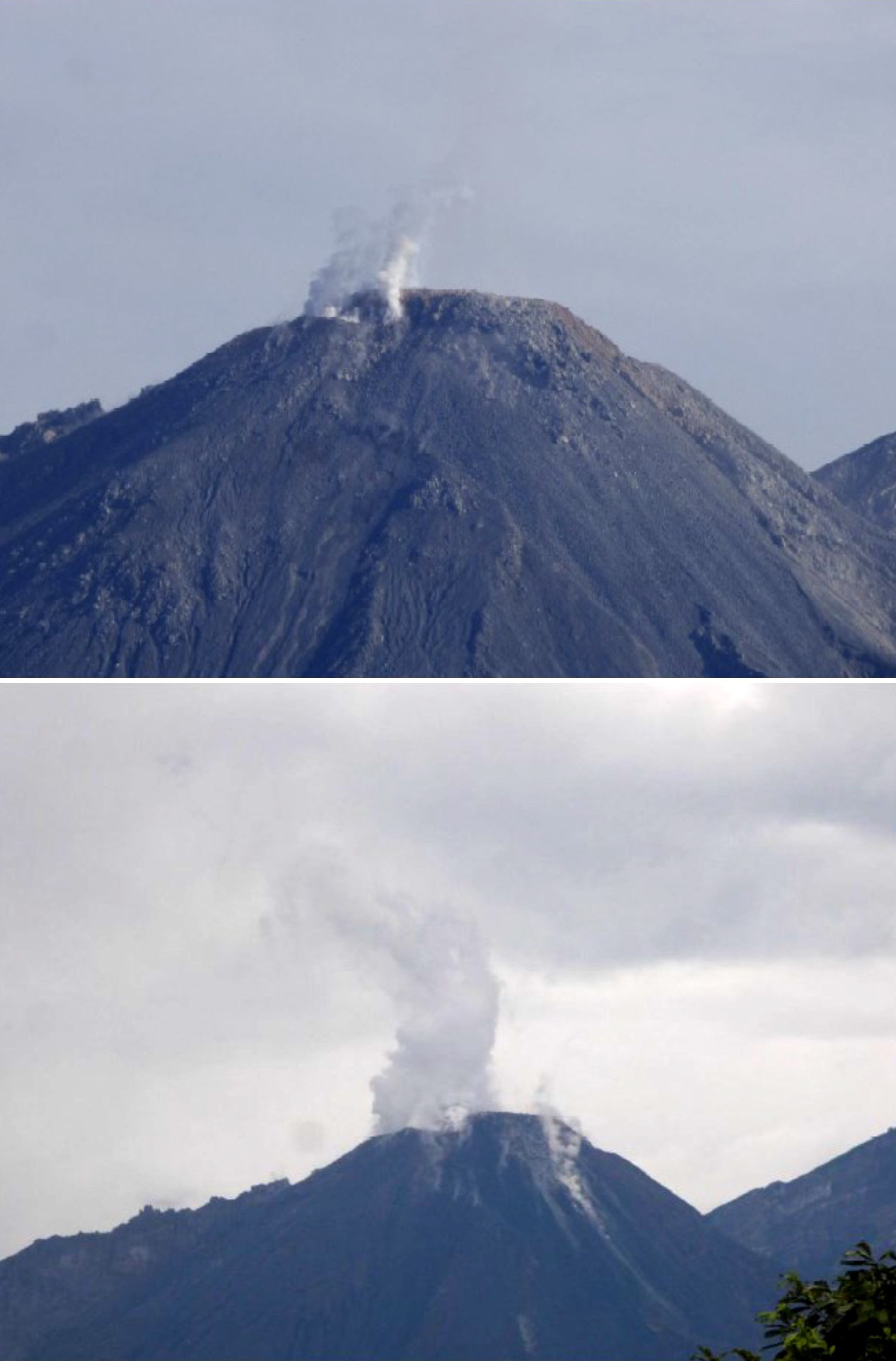 |
Figure 85. Degassing of the Santa Maria Caliente dome forming white plumes during August 2018. Courtesy of INSIVUMEH (27 July-3 August 2018 and 4-10 August 2018, respectively). |
Throughout September, degassing and fumarole activity of the Caliente dome produced white plumes up to 3.1 km. Explosions produced ash plumes that reached altitudes of 3.3 km up to 13 times per day. Degassing and ash plumes were most often dispersed to the SW, and sometimes to the W and SE. Red discoloration of ash was noted on 4 September due to the oxidation of the dome rock where the explosion was generated (figure 86). Ashfall often occurred within the proximity of the volcano. Avalanches were often reported as constant on the SE flank of the dome and sometimes occurring on the NE and E flanks. On 12 September a lahar was recorded traveling down both tributaries of the Samalá River. A larger lahar was generated on 20 September in the San Isidro-Tambor tributaries of the Samala River with a width of 25 m and a thickness of 2 m. The lahar carried tree trunks and branches, and blocks up to 2 m in diameter. A third lahar occurred on 24 September down the Cabello de Ángel River, with a width of 15 m, a thickness of 1.5 m, and carrying blocks up to 2 m in diameter.
Degassing at the dome during October produced white plumes to a maximum altitude of 3.2 km (figure 87). Explosions generated white and gray ash plumes up to 3.2 km, with up to 11 explosions recorded per day and an average of 8-9 per day. Plumes were often directed towards the SE, and sometimes to the W and NW. Ashfall frequently occurred on the slopes and was reported in Monte Claro on 16 and 26 October. Avalanches were frequent on the SE flank of the dome, and sometimes occurred on the W and NE flanks (figure 88). Incandescent material was observed during explosions on the 23rd. Two lahars were generated on 9 October; one traveled down the Cabello de Ángel river channel with a width of 20 m, a thickness of 2 m, and carrying blocks as large as 3 m in diameter. The second was 15-m-wide with a thickness of 1 m and blocks as large as 2 m in diameter which traveled down the San Isidro River.
Geological Summary. Symmetrical, forest-covered Santa María volcano is part of a chain of large stratovolcanoes that rise above the Pacific coastal plain of Guatemala. The sharp-topped, conical profile is cut on the SW flank by a 1.5-km-wide crater. The oval-shaped crater extends from just below the summit to the lower flank, and was formed during a catastrophic eruption in 1902. The renowned Plinian eruption of 1902 that devastated much of SW Guatemala followed a long repose period after construction of the large basaltic-andesite stratovolcano. The massive dacitic Santiaguito lava-dome complex has been growing at the base of the 1902 crater since 1922. Compound dome growth at Santiaguito has occurred episodically from four vents, with activity progressing E towards the most recent, Caliente. Dome growth has been accompanied by almost continuous minor explosions, with periodic lava extrusion, larger explosions, pyroclastic flows, and lahars.
Information Contacts: Instituto Nacional de Sismologia, Vulcanologia, Meteorologia e Hydrologia (INSIVUMEH), Unit of Volcanology, Geologic Department of Investigation and Services, 7a Av. 14-57, Zona 13, Guatemala City, Guatemala (URL: http://www.insivumeh.gob.gt/ ); MIROVA (Middle InfraRed Observation of Volcanic Activity), a collaborative project between the Universities of Turin and Florence (Italy) supported by the Centre for Volcanic Risk of the Italian Civil Protection Department (URL: http://www.mirovaweb.it/).


